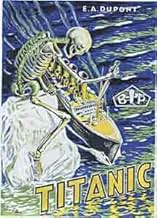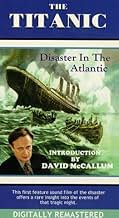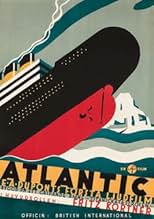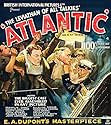Aggiungi una trama nella tua linguaOn its maiden voyage in April 1912, the supposedly unsinkable RMS Titanic hits an iceberg in the Atlantic Ocean.On its maiden voyage in April 1912, the supposedly unsinkable RMS Titanic hits an iceberg in the Atlantic Ocean.On its maiden voyage in April 1912, the supposedly unsinkable RMS Titanic hits an iceberg in the Atlantic Ocean.
- Regia
- Sceneggiatura
- Star
Gordon James
- Capt. Collins
- (as Sydney Lynn)
Recensioni in evidenza
For some reason this 1929 film was titled Atlantic when it could have easily been titled Titanic, or something with "Titanic" in its title (however it has been released on video as Titanic.) I suppose they might have titled it Atlantic due to fictional characters and stories that didn't really happen on The Titanic and its fateful voyage, but the story of the film is clearly the disaster that happened to The Titanic. The ship in the film is crossing The Atlantic, and enters areas known to have icebergs. Many of the characters introduced are wealthy types, and we know there were very rich and prominent passengers on The Titanic. Some of the characters include: A husband and father, who cheats on his wife during the voyage; his wife, who tearfully knows her husband was with another woman; their daughter, who outspokenly resents her father for cheating on her mother; a recently wed couple with child on the way; a wheelchair bound gentleman who seems to become the wisdom during the crisis; his wife, who will not leave his side when it's "women and children first;" and a man who seems to drink heavily even before the disaster happens. During the voyage the ship strikes an iceberg, and begins to sink. Lifeboats are being filled with women and children as the ship sends S.O.S. Pandemonium breaks out with many passengers, but our main characters seem to fall into a sad calmness. There is a gathering of many passengers in a lounge, and they drink or play cards to pass the time while waiting to die. On another part of the ship, people are huddled together and singing, "Nearer My God To Thee." Soon all goes black and we know the ship has gone down. This is where the film ends, and there are no scenes of the lifeboats after the sinking. Nor are we shown any scenes of surviving characters, or a rescue ship. Obviously many facts of what happened on The Titanic are correctly portrayed, but other events in Atlantic are either incorrect to The Titanic's disaster, or added as fiction. Atlantic was released by British International Pictures, and the quality of this feature is fine. The film has its typical (of the era) share of crudeness (grainy, jumping, lighting, editing), and there are several instances where it seems like a silent film. There are a couple instances where cheerful music seems very inappropriate to situations going on in the film, (I don't mean when the band begins to play as passengers are being put in lifeboats; this inappropriate music is before the ship strikes the iceberg.) There are a few instances of continuity errors in Atlantic. Atlantic does not attempt much in the way of special effects, but what is attempted is nicely done. The sinking of the ship is not shown, but is indicated when the screen goes black one final time. Having the film end right at the sinking creates a feeling of incompleteness, and it seems the story should have had a more meaningful conclusion. The acting in Atlantic is fair to good, and the film as a whole is fair to good. I found the film to be more thought-provoking than exciting, and it is an interesting disaster effort.
let me firstly say that too many of these reviewers ,particularly the film student,are viewing the film in a modern context and not as a film made at the coming of sound.In an interview given by John Longden for the BBCs programme "Yesterdays witness" he stated that the ridiculously long pauses between dialogue were entirely the idea of the director.So it is unfair to blame the actors for this.Also in that same programme sound men were interviewed.They said that the effects were recorded on a liner berthed at Tilbury.The ship was linked by phone line to Elstree studios.Before each effect someone would come on the line to describe the effect and it would be recorded at Elstree.The problems with early sound films were quite apparent here.few directors here or in America had the skill of Hitchcock in adapting to the new medium.In fact one should praise the attempt to tell the story in what was then effectively a new medium rather than decry the effort some 84 years later because it is old fashioned.no doubt in the year 2097 young film students will be looking at the like of Man of Steel and chuckling at its antique quaintness.
I was very surprised that I found this 1929 film on YouTube today.. I had no idea it existed and I was excited to see a talking picture made only a decade and a half after the disaster. However, my excitement turned out to be rather muted, as instead of having a grand scope (as ANY picture about the Titanic should have), it looks amazingly claustrophobic. Despite the ship having about 3300 folks aboard (counting crew and passengers), you mostly see scenes with a small handful of folks in them!! I think this is for two reasons. First, the film was obviously made on the cheap. Second, 1929 was the first year for sound pictures in the UK and like the earlier American films of 1927-28, the sound technology was primitive and they had no idea how to film large rooms full of people. Instead, folks had to stand around hidden microphones and talk...which seems unnatural when you see such movies.
As for the title, apparently the White Star Line had a lot of nerve and wouldn't allow the studio to use the name 'Titanic'. I am no barrister, so I have no idea about British law, but this seems more a ploy by White Star than a legitimate case where a copyright or trademark is involved. The sinking of the Titanic was a historical event and mentioning this and the ship's name seem reasonable...and I am not sure why the studio caved and named the movie 'Atlantic' instead of 'Titanic'...but they did.
One thing that was bad about the movie but isn't the filmmakers' fault is that the print is rather jerky and it jiggles a bit. You probably won't need Dramamine to watch the picture, but it is noticeable and annoying.
Another thing to note is that there apparently were several versions of the movie. In the earliest days of sound, they studios had no idea how to dub films into other languages...so they filmed multiple versions in various languages. Laurel & Hardy did this, the Bela Lugosi version of "Dracula" has another version starring a Mexican count and with "Atlantic", they filmed it in German, English AND as a silent (as most theaters didn't have the technology to play sound films yet). And, after finishing the filming, the film was re-cut and French language scenes were added. I saw the English language version...and have no idea if these other versions even exist today nor where you can find them if they do exist.
The movie is odd in that it just begins on the ship in a small drawing room just before the ill-fated crash. I checked...the print I saw WAS the entire 90 minute picture and the normal introduction apparently just wasn't made. This provided little in the way of suspense and over an hour of the film consists of what happens after the ship collides with an iceberg. And, since it was made with very few extras and cast, the whole thing seems a bit small and anticlimactic. But I do cut the film some slack because of when it was made....expecting the same spectacle as in the Nazi propaganda film "Titanic" (1943) or "A Night to Remember" (1958) or "Titanic" (1997) would be ridiculous. Cramped productions were certainly the norm until about 1930-31....and, in hindsight, it might have worked better had they just waited a year or so to make the movie. Additionally, the film lacks reasonably well developed characters and even for 1929, it was a bit of a disappointment in this regard. So, overall it's a very mixed bag for 1929...and a film that must have impressed back in the day but which became quickly dated as well. Mostly of value to the curious and film historians. I give it a 5 because it is watchable and some of the scenes were well made...but overall, it is disappointing and cramped!
As for the title, apparently the White Star Line had a lot of nerve and wouldn't allow the studio to use the name 'Titanic'. I am no barrister, so I have no idea about British law, but this seems more a ploy by White Star than a legitimate case where a copyright or trademark is involved. The sinking of the Titanic was a historical event and mentioning this and the ship's name seem reasonable...and I am not sure why the studio caved and named the movie 'Atlantic' instead of 'Titanic'...but they did.
One thing that was bad about the movie but isn't the filmmakers' fault is that the print is rather jerky and it jiggles a bit. You probably won't need Dramamine to watch the picture, but it is noticeable and annoying.
Another thing to note is that there apparently were several versions of the movie. In the earliest days of sound, they studios had no idea how to dub films into other languages...so they filmed multiple versions in various languages. Laurel & Hardy did this, the Bela Lugosi version of "Dracula" has another version starring a Mexican count and with "Atlantic", they filmed it in German, English AND as a silent (as most theaters didn't have the technology to play sound films yet). And, after finishing the filming, the film was re-cut and French language scenes were added. I saw the English language version...and have no idea if these other versions even exist today nor where you can find them if they do exist.
The movie is odd in that it just begins on the ship in a small drawing room just before the ill-fated crash. I checked...the print I saw WAS the entire 90 minute picture and the normal introduction apparently just wasn't made. This provided little in the way of suspense and over an hour of the film consists of what happens after the ship collides with an iceberg. And, since it was made with very few extras and cast, the whole thing seems a bit small and anticlimactic. But I do cut the film some slack because of when it was made....expecting the same spectacle as in the Nazi propaganda film "Titanic" (1943) or "A Night to Remember" (1958) or "Titanic" (1997) would be ridiculous. Cramped productions were certainly the norm until about 1930-31....and, in hindsight, it might have worked better had they just waited a year or so to make the movie. Additionally, the film lacks reasonably well developed characters and even for 1929, it was a bit of a disappointment in this regard. So, overall it's a very mixed bag for 1929...and a film that must have impressed back in the day but which became quickly dated as well. Mostly of value to the curious and film historians. I give it a 5 because it is watchable and some of the scenes were well made...but overall, it is disappointing and cramped!
True this movie is creaky by today's standards. It's a British maritime story & British production directed by a German Expressionists director who himself was getting acquainted with sound at the time. I had waited a long time to see this film in it's entirety when I found a video two-tape copy in a Sam Goodys. Before I had only seen clips of this in Titanic documentaries. If the Producers changed the Title from Titanic to Atlantic it was more in conjunction with the movie being made only 17 years after the real disaster. Many of the survivors' relatives would have been alive and well and lawsuits would have probably abounded from them as well as The White Star Line, the Titanic's owner, which was still up and running and had an image to uphold. Remember at this time the White Star Line considered the Titanic as a ship they'd rather forget. But even with the title being Atlantic the film's makers infringed upon an earlier White Star disaster in 1873 with over 300 lives lost. The ship from the 1873 disaster was called: THE ATLANTIC. The biggest White Star disaster 39 years before the Titanic.
This movie, based on an earlier stage production, was a big undertaking for 1929 sound film. Dupont is obviously a novice with sound technique. Dialogue from characters such as Tate-Hughes is often spoken in a slow-witted fashion presumably for some kind of stage effect. Characters are given names to protect the identities of the real life victims. So Captain EJ Smith-becomes-"The Captain", Charles Lighttoller-becomes-simply "Lanchester", Ben Guggenheim-becomes-"Tate-Hughes" albeit in a wheel chair and so on. Charleston type music is played instead the Ragtime & Waltzes that were actually heard on the Titanic. But Dupont set a standard with this film that all later Titanic films imitated in one way or another. This film shows the goings-on on the bridge, scenes of the engine room(pretty good by the way), the effects on important first class passengers, the steerage passengers in the lower holds and the sinking, while very stagey, is handled poignantly with the cast singing Nearer My God To Thee...this was imitated in the 1953 Titanic w/Barbara Stanwyck. But there was no visual aspect of the actual ship sinking. Perhaps a bit to harrowing to portray since it was only 17 years and the disaster would've still been fresh in some survivors minds.
Most Titanic buffs should want to see this just to see how 1929 audiences would have handled the sinking of the Titanic as told through a fictional ship called Atlantic. It's an obvious story on the Titanic but done to protect survivors & relatives of which many were living at the time. Seeing this, one can compare it to Titanic(1953), A Night To Remember(1958 classic), the made for tv S.O.S Titanic(1979) or the recent James Cameron Oscar winner. I would give it just for historical purposes 2 1/2 stars out of 4.
This movie, based on an earlier stage production, was a big undertaking for 1929 sound film. Dupont is obviously a novice with sound technique. Dialogue from characters such as Tate-Hughes is often spoken in a slow-witted fashion presumably for some kind of stage effect. Characters are given names to protect the identities of the real life victims. So Captain EJ Smith-becomes-"The Captain", Charles Lighttoller-becomes-simply "Lanchester", Ben Guggenheim-becomes-"Tate-Hughes" albeit in a wheel chair and so on. Charleston type music is played instead the Ragtime & Waltzes that were actually heard on the Titanic. But Dupont set a standard with this film that all later Titanic films imitated in one way or another. This film shows the goings-on on the bridge, scenes of the engine room(pretty good by the way), the effects on important first class passengers, the steerage passengers in the lower holds and the sinking, while very stagey, is handled poignantly with the cast singing Nearer My God To Thee...this was imitated in the 1953 Titanic w/Barbara Stanwyck. But there was no visual aspect of the actual ship sinking. Perhaps a bit to harrowing to portray since it was only 17 years and the disaster would've still been fresh in some survivors minds.
Most Titanic buffs should want to see this just to see how 1929 audiences would have handled the sinking of the Titanic as told through a fictional ship called Atlantic. It's an obvious story on the Titanic but done to protect survivors & relatives of which many were living at the time. Seeing this, one can compare it to Titanic(1953), A Night To Remember(1958 classic), the made for tv S.O.S Titanic(1979) or the recent James Cameron Oscar winner. I would give it just for historical purposes 2 1/2 stars out of 4.
How interesting that E.A. Dupont who created one of germany's most memorable silent films (VARIETY) also helmed one of England's first talkies. Obviously he was uneasy with the medium of talking pictures, note how the first 6 minutes of this film is entirely visual. Most of the cast had stage experience, you can tell because they over-exaggerate their lines and cannon out the words like they were playing to the back row. Still this is a well paced dramatic film and the final few minutes have an impact that can stand on their own alongside the later versions, TITANIC and A NIGHT TO REMEMBER. (I am deliberately excluding James Cameron's film with its budget that would have fed a 3rd World country for 10 years and its plethora of computer FX.)
Lo sapevi?
- QuizThe White Star Line forbade the production company from referring to the ship in this film as The Titanic.
- BlooperSet in 1912, he women's hairstyle and dresses are from 1929.
- Versioni alternativeReleased with separate English, French and German soundtracks.
- ConnessioniAlternate-language version of Atlantik (1929)
- Colonne sonoreWalking With Susie
(uncredited)
Written by G.H. Elliott
Played by the ship's band as Larry and Monica enter the Smoking Room.
I più visti
Accedi per valutare e creare un elenco di titoli salvati per ottenere consigli personalizzati
Dettagli
- Data di uscita
- Paese di origine
- Lingua
- Celebre anche come
- Titanic: Disaster in the Atlantic
- Luoghi delle riprese
- Azienda produttrice
- Vedi altri crediti dell’azienda su IMDbPro
Botteghino
- Budget
- 2000 £ (previsto)
- Tempo di esecuzione
- 1h 30min(90 min)
- Colore
- Proporzioni
- 1.20 : 1
Contribuisci a questa pagina
Suggerisci una modifica o aggiungi i contenuti mancanti



































